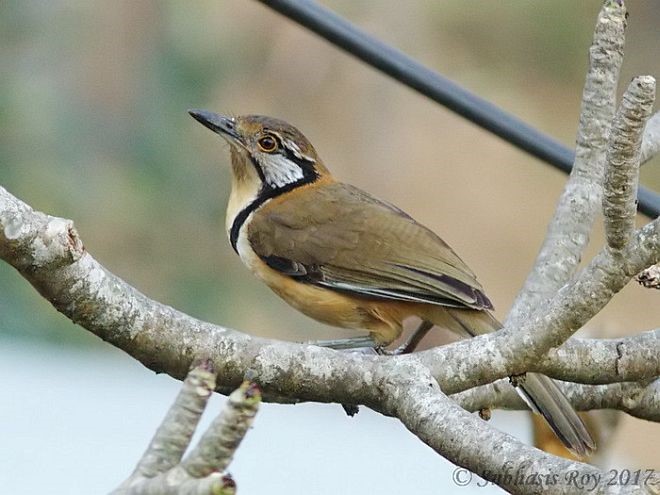Birdfinding.info ⇒ Widespread and locally common across much of its range, but habitually secretive and difficult to observe except at established hides. Sites where it can often be found include: in West Bengal, Mahananda Wildlife Sanctuary; in Assam, Garbhanga Forest Reserve; in Yunnan, Hongbenghe; in Fujian, Emei Fang; and in Thailand, Kaeng Krachan National Park and Song Phi Nong. In Hong Kong, it can be found at forest sites such Tai Tong, Ho Pui Reservoir, Tai Mo Shan Country Park, and Tai Po Kau Nature Reserve. On Kauai it is unpredictable, but sometimes found at Hanalei and Huleia National Wildlife Refuges and Wailua River Valley.
Greater Necklaced Laughingthrush
Ianthocincla pectoralis
Family: Leiothrichidae
Hill country of eastern and southern Asia.
Inhabits foothill forests from the Himalayas of central Nepal and hill country from Bangladesh east throughout most of Myanmar locally across southern, central, and eastern China (north to southern Shaanxi and northern Jiangsu), including Hainan, and south to western and central Thailand, eastern Laos and central Vietnam.
An introduced population is well-established on Kauai, descended from intentional releases around 1919.
Identification
A large, robust, gregarious, jaylike laughingthrush with a prominent black mask and necklace pattern.
Many plumage details vary widely among the subspecies—including the shape, color and extent of the mask and necklace, and the general coloration of the underparts.
The upperparts are mostly warm-brown, with a rusty nape collar, and the underparts are a variable mix of whitish, buffy, and rusty.
The irises are dark-brown or red (unlike Lesser Necklaced Laughingthrush; see below)—although the orbital skin is often bright yellow or orange, which can appear to be its eye-color.
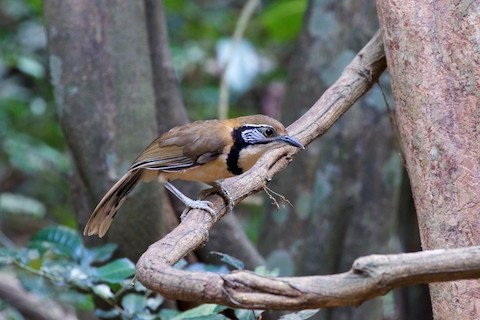
Greater Necklaced Laughingthrush, I. p. subfusa. (Song Phi Nong, Phetchaburi, Thailand; February 12, 2019.) © Jeanne Verhulst
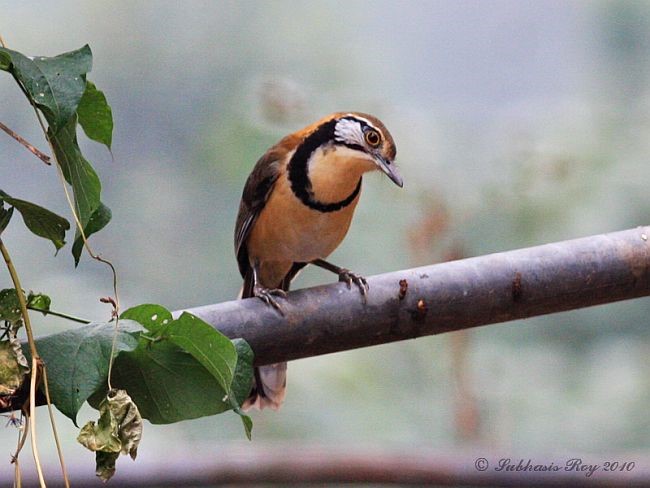
Greater Necklaced Laughingthrush, I. p. pectoralis. (Rangitnagar, South Sikkim, India; December 25, 2010.) © Subhasis Roy

Greater Necklaced Laughingthrush, I. p. subfusa. (Song Phi Nong, Phetchaburi, Thailand; March 9, 2019.) © Tim Avery
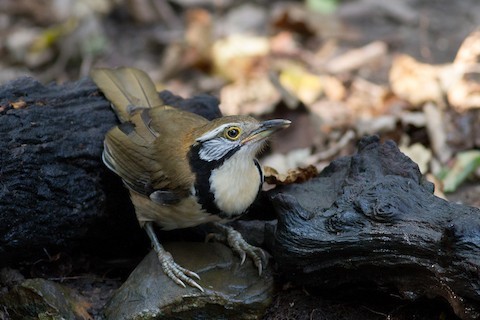
Greater Necklaced Laughingthrush, I. p. subfusa. (Song Phi Nong, Phetchaburi, Thailand; January 9, 2014.) © Raphael Lebrun

Greater Necklaced Laughingthrush, I. p. melanotis. (Hathikhira Tea Estate, Karimganj, Assam, India; April 7, 2013.) © Vijay Anand Ismavel
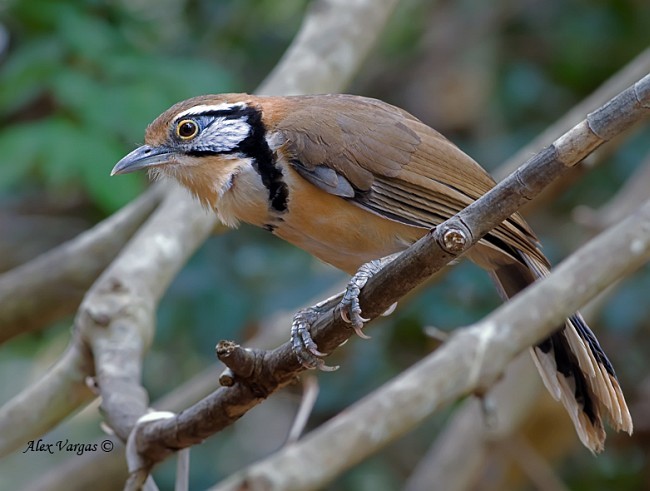
Greater Necklaced Laughingthrush, I. p. subfusa. (Baan Song Nok, Phetchaburi, Thailand; January 25, 2011.) © Alex Vargas

Greater Necklaced Laughingthrush, I. p. pectoralis. (Mahananda Wildlife Sanctuary, West Bengal, India; November 10, 2011.) © Debapratim Saha

Greater Necklaced Laughingthrush, I. p. subfusa. (Song Phi Nong, Phetchaburi, Thailand; March 9, 2019.) © Tim Avery
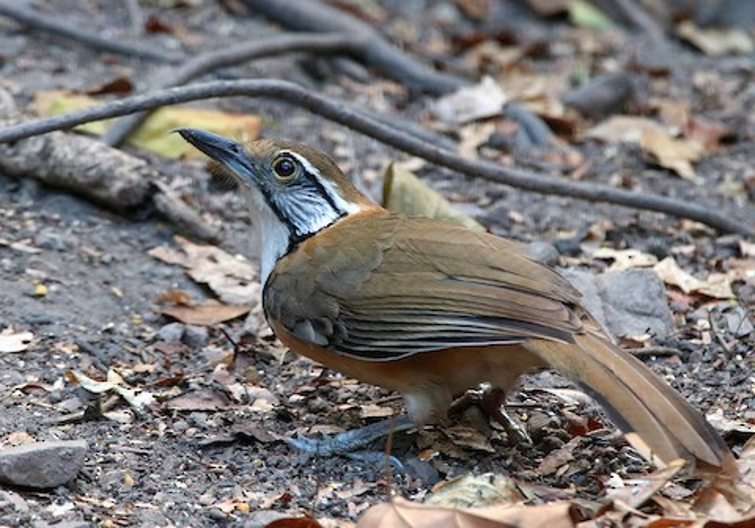
Greater Necklaced Laughingthrush, I. p. subfusa. (Song Phi Nong, Phetchaburi, Thailand; March 9, 2019.) © Tim Avery
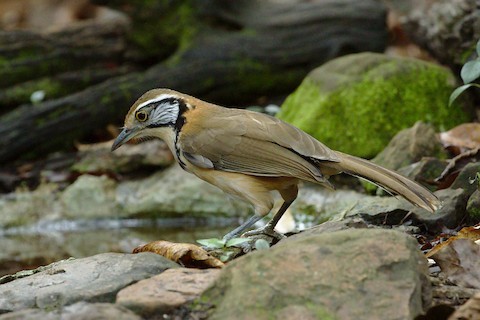
Greater Necklaced Laughingthrush, I. p. subfusa. (Song Phi Nong, Phetchaburi, Thailand; March 1, 2018.) © Tom Tarrant
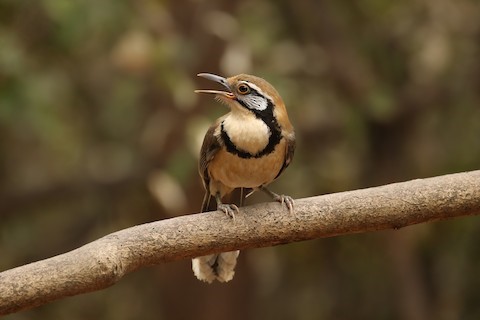
Greater Necklaced Laughingthrush, I. p. subfusa. (Song Phi Nong, Phetchaburi, Thailand; March 18, 2020.) © Frank Thierfelder

Greater Necklaced Laughingthrush, I. p. subfusa. (Song Phi Nong, Phetchaburi, Thailand; March 11, 2019.) © Carlos Sanchez
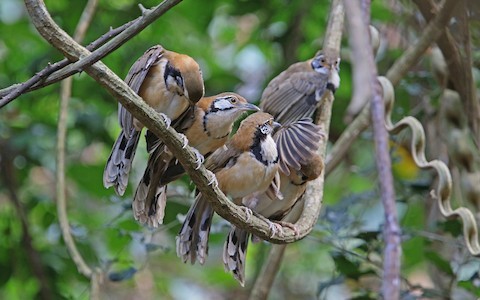
Greater Necklaced Laughingthrush, I. p. subfusa. (Song Phi Nong, Phetchaburi, Thailand; March 2, 2019.) © Christoph Moning

Greater Necklaced Laughingthrush, I. p. subfusa. (Song Phi Nong, Phetchaburi, Thailand; March 18, 2020.) © Frank Thierfelder
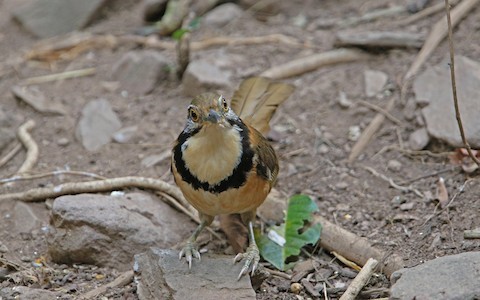
Greater Necklaced Laughingthrush, I. p. subfusa. (Song Phi Nong, Phetchaburi, Thailand; March 2, 2019.) © Christoph Moning
In most races, the mask is a patch of black-and-whitish streaks across the cheeks and ears, framed by two thin black lines above and below. However, some populations have more extensively black masks—especially in southern Assam and some parts of China.
The shape of the “necklace” varies widely among the races. Some have a fairly uniform black border that extends from the back of the mask down the sides of the neck, then curves across the chest, joining in the middle. Others have broad black bars down the sides of the neck and a thin or indistinct band across the chest. Others have broad grayish bars down the sides of the neck.

Greater Necklaced Laughingthrush, I. p. pectoralis. (Rangitnagar, South Sikkim, India; December 25, 2010.) © Subhasis Roy

Greater Necklaced Laughingthrush, I. p. pectoralis. (Mahananda Wildlife Sanctuary, West Bengal, India; September 10, 2011.) © Debapratim Saha

Greater Necklaced Laughingthrush, I. p. picticollis. (Wan Chai, Hong Kong; May 9, 2020.) © lingyuetyin
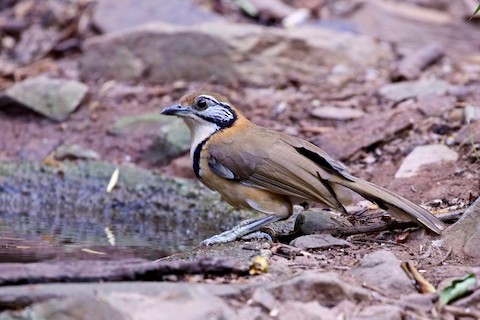
Greater Necklaced Laughingthrush, I. p. subfusa. (Song Phi Nong, Phetchaburi, Thailand; February 12, 2019.) © Jeanne Verhulst

Greater Necklaced Laughingthrush, I. p. picticollis. (Tai Tong, Hong Kong; April 29, 2020.) © Matthew Kwan

Greater Necklaced Laughingthrush, I. p. picticollis. (Woh Chai Shan, Hong Kong; January 15, 2015.) © John Clough
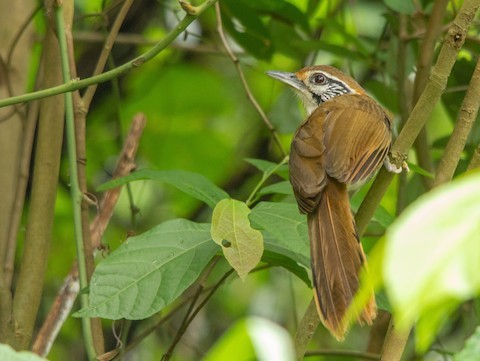
Greater Necklaced Laughingthrush, I. p. picticollis. (Tanglashan Country Park, Guangdong, China; May 7, 2019.) © Andrew Thornton

Greater Necklaced Laughingthrush, I. p. picticollis. (Victoria Peak Garden, Hong Kong; February 11, 2018.) © Marcel Finlay
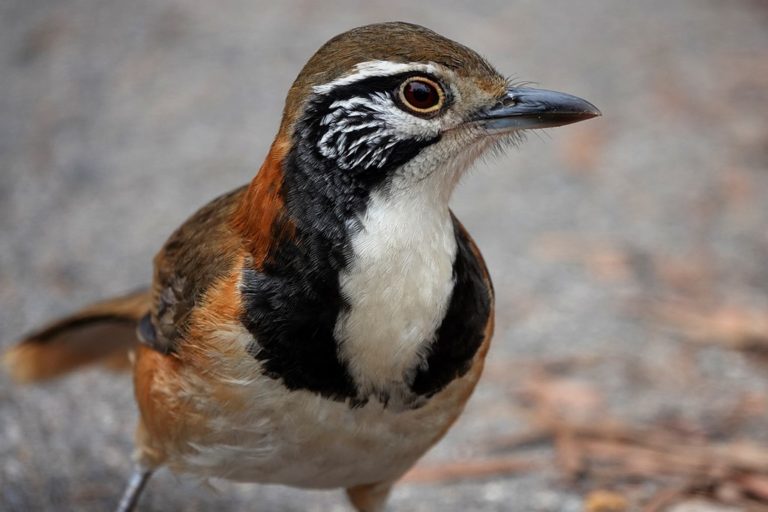
Greater Necklaced Laughingthrush, I. p. picticollis. (Hong Kong; April 18, 2020.) © Carol Kwok
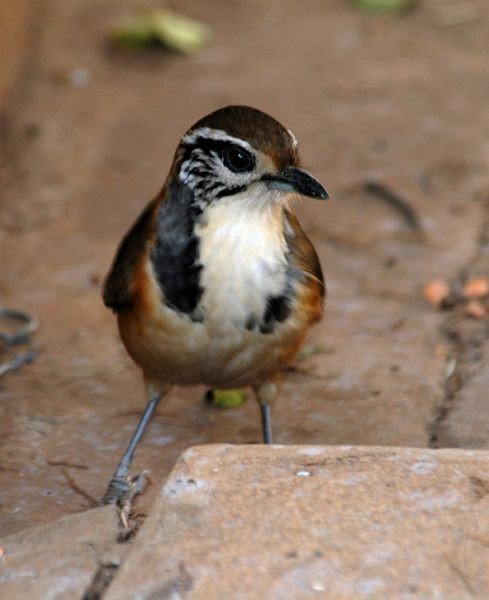
Greater Necklaced Laughingthrush, I. p. robini. (Kunming, Yunnan, China; January 17, 2007.) © David Blank

Greater Necklaced Laughingthrush, I. p. robini. (Kunming, Yunnan, China; January 17, 2007.) © David Blank

Greater Necklaced Laughingthrush, I. p. picticollis. (Mount Parker Road, Hong Kong; February 24, 2020.) © Thomas Tam

Greater Necklaced Laughingthrush, I. p. picticollis. (Quan Shui Wan, Henan, China; January 1, 2019.) © Josep del Hoyo

Greater Necklaced Laughingthrush, I. p. picticollis. (Tai Po Kau, Hong Kong; January 11, 2011.) © Martin Hale
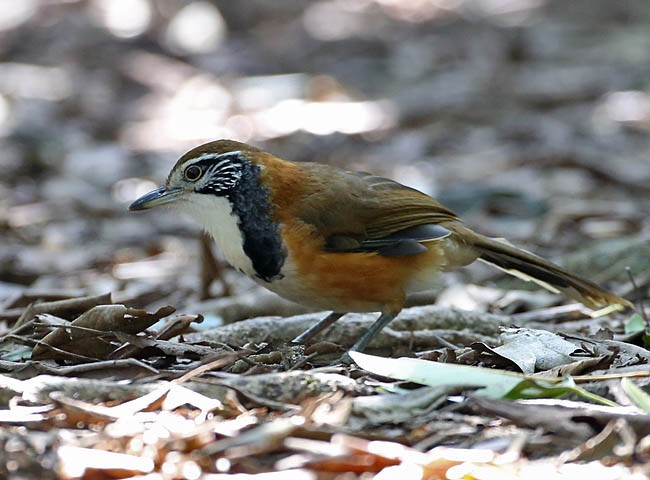
Greater Necklaced Laughingthrush, I. p. picticollis. (Tai Po Kau, Hong Kong; January 5, 2013.) © Cherry Wong
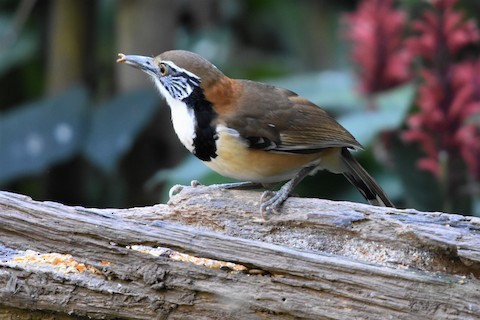
Greater Necklaced Laughingthrush, I. p. robini. (Hongbenghe, Yunnan, China; January 5, 2018.) © Steve Bale
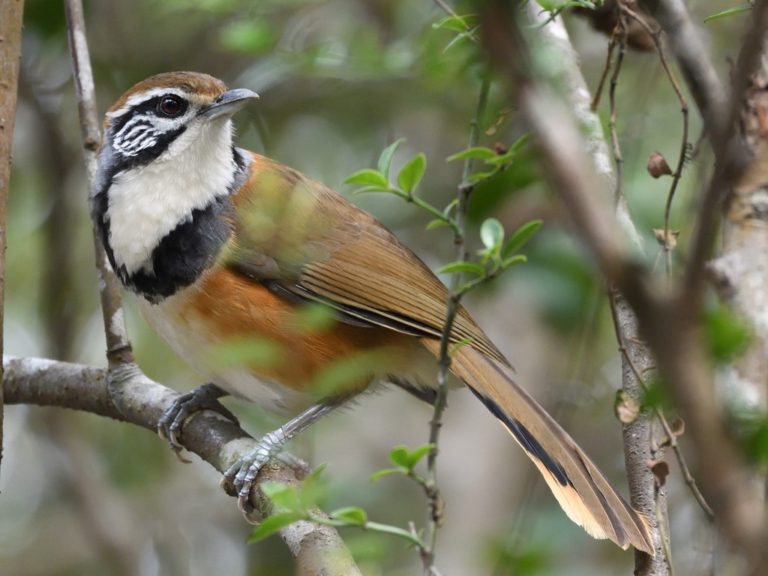
Greater Necklaced Laughingthrush, I. p. picticollis. (Mount Parker Road, Hong Kong; February 24, 2020.) © Thomas Tam

Greater Necklaced Laughingthrush, I. p. melanotis. (Rangitnagar, South Sikkim, India; December 14, 2010.) © Subhasis Roy
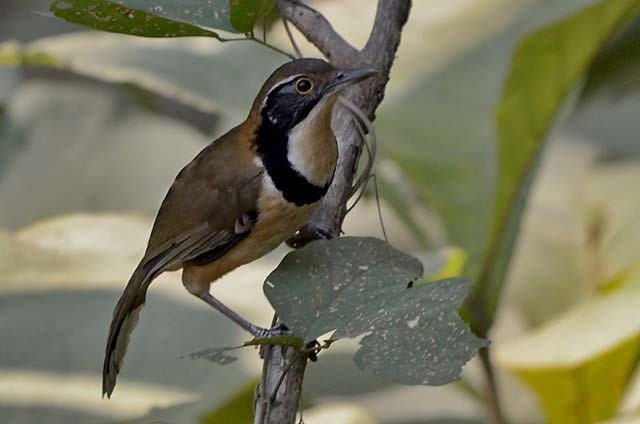
Greater Necklaced Laughingthrush, I. p. melanotis. (Guwahati, Assam, India; December 30, 2012.) © Raj Kamal Phukan

Greater Necklaced Laughingthrush, I. p. melanotis. (Garbhanga Reserved Forest, Guwahati, Assam, India; November 22, 2017.) © Iftiaque Hussain
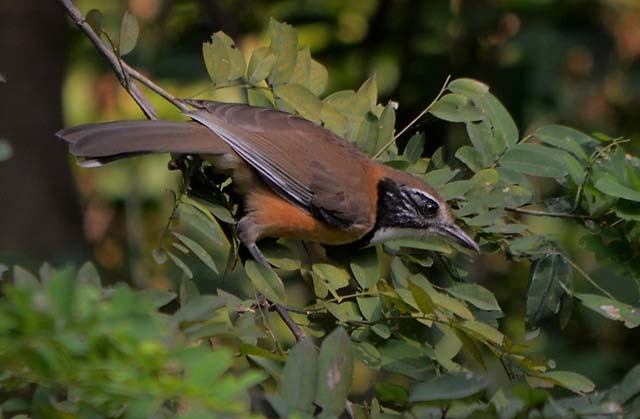
Greater Necklaced Laughingthrush, I. p. melanotis. (Guwahati, Assam, India; October 20, 2012.) © Raj Kamal Phukan
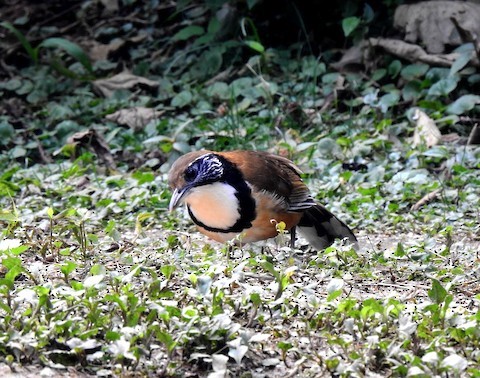
Greater Necklaced Laughingthrush, I. p. robini. (Hongbenghe, Yunnan, China; February 2, 2018.) © Liao Tzu-Chiang

Greater Necklaced Laughingthrush, I. p. robini. (Hongbenghe, Yunnan, China; January 5, 2018.) © Steve Bale
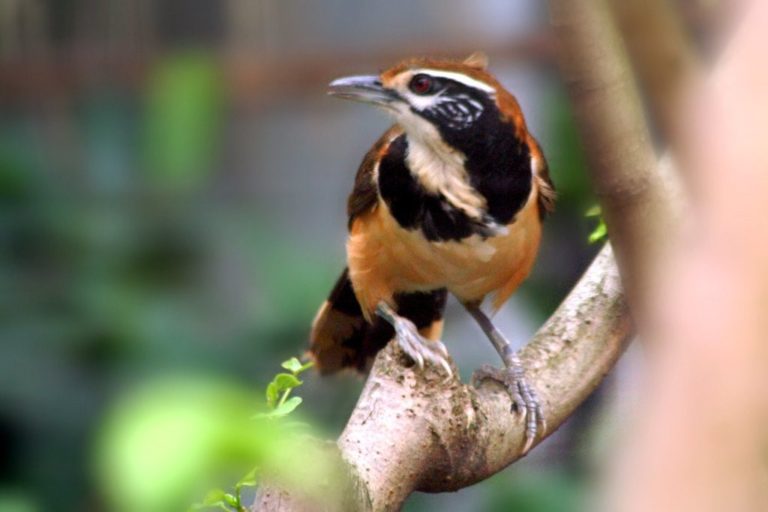
Greater Necklaced Laughingthrush, I. p. robini. (Kunming, Yunnan, China; April 7, 2011.) © Don-Jean Léandri-Breton

Greater Necklaced Laughingthrush, I. p. melanotis. (Guwahati, Assam, India; December 30, 2012.) © Raj Kamal Phukan
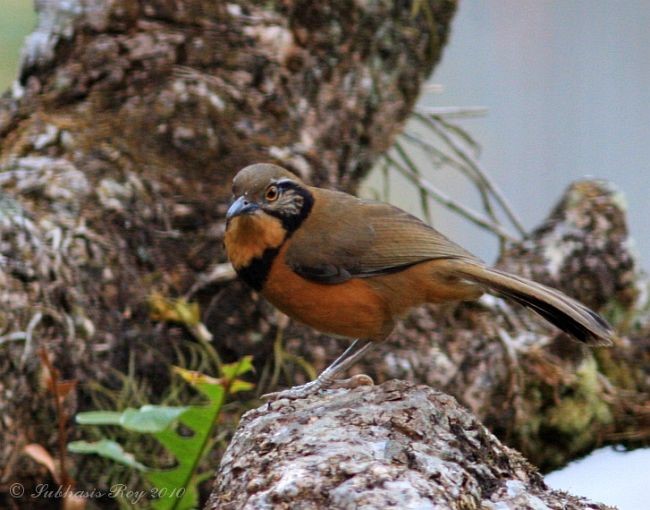
Greater Necklaced Laughingthrush, I. p. pectoralis. (Rangitnagar, South Sikkim, India; December 14, 2010.) © Subhasis Roy
Cf. Lesser Necklaced Laughingthrush. Greater and Lesser Necklaced Laughingthrushes are a peculiar pair. Despite not being closely related, they have very similar plumage patterns and coloration and mostly coextensive ranges, and they regularly occur together in mixed flocks. Both species vary widely in pattern and coloration, and to some extent in size—with a surprising degree of overlap on all factors.
Neither plumage nor size are reliably diagnostic, but eye color is. Lesser has yellow irises, whereas Greater’s irises are dark. Even this reliable distinction can be confusing, however, as Greater’s orbital skin can be bright yellow or orange, which can be confused with eye-color.
Notes
Polytypic species consisting of five or six recognized subspecies.
References
BirdLife International. 2016. Garrulax pectoralis. The IUCN Red List of Threatened Species 2016: e.T22715611A94461376. https://dx.doi.org/10.2305/IUCN.UK.2016-3.RLTS.T22715611A94461376.en. (Accessed October 31, 2020.)
Brazil, M. 2009. Birds of East Asia. Princeton University Press.
eBird. 2020. eBird: An online database of bird distribution and abundance. Cornell Lab of Ornithology, Ithaca, N.Y. http://www.ebird.org. (Accessed October 31, 2020.)
Raine, H., and A.F. Raine. 2020. ABA Field Guide to the Birds of Hawai’i. Scott & Nix, Inc., New York.
Pratt, H.D., P.L. Bruner, and D.G. Berrett. 1987. A Field Guide to the Birds of Hawaii and the Tropical Pacific. Princeton University Press.
Pyle, R.L., and P. Pyle. 2017. The Birds of the Hawaiian Islands: Occurrence, History, Distribution, and Status. Version 2 (January 1, 2017). http://hbs.bishopmuseum.org/birds/rlp-monograph/. B.P. Bishop Museum, Honolulu, Hawaii.
Xeno-Canto. 2020. Greater Necklaced Laughingthrush – Pterorhinus pectoralis. https://www.xeno-canto.org/species/Pterorhinus-pectoralis. (Accessed October 31, 2020.)
